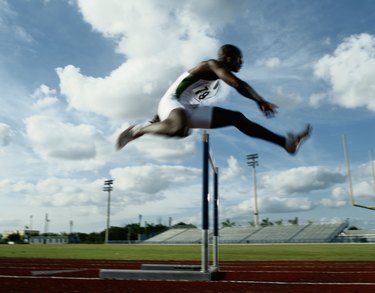
Hurdles can be intimidating at first, especially if you're not particularly flexible. To practice, it can help to take the hurdle out of the equation and work on drills that prepare you for hurdling. This builds your confidence before you try to take a leap over the hurdles.
In hurdles, not only do you have to run fast but you have to jump and land quickly, minimizing the amount of time you're in the air. If you do it right, it doesn't look like you're jumping — it looks like you're just lifting your legs. Drills allow you to break down each aspect of your form and work on each aspect one at a time. While you need to practice jumping hurdles and using them for other timing drills, you should spend time in training without them.
Video of the Day
Video of the Day
Read More: Rules for Track Hurdles
Rhythm Drill
When you hurdle, the lead leg rises up and falls back to the ground while the trail leg lags slightly behind. It can be awkward to figure out when to raise and lower each leg, which is why you should learn without a hurdle using this drill.
How to: Jog slowly in a straight line. Push off the ground with your trail leg and drive your lead knee up. When your lead knee is up in the air, bring your trail knee up. Your lead leg starts to drop as your trail leg rises. Land on the ground on your lead leg first, then your trail leg shortly after.
Stride Pattern
Hurdlers have a set number of strides that they can take between each hurdle to keep their timing impeccable. This cone drill will help you get a feel for how many strides you'll take during a race.
How to: From the start line, place seven cones between where your first stride lands and where the first hurdle would be. After that, place three cones every 10 meters, as evenly spaced as possible. Adjust the cones, so they're the distance is the size of your stride when you're running your fastest.

Karate Kid
When you land after clearing a hurdle, your lead leg touches the ground first and your trail leg follows. It's important that your trail leg doesn't go too far in front of you — it should land in line with your lead leg. Use this drill to get a feel for where to land with your trail leg.
How to: Raise your trail leg in front of you, with your knee bent at 90 degrees. Drive off of your lead leg and hop forward. Keep your trail leg in the air and land on the lead leg, then hop again. Hop a third time and, after your lead leg hits the ground, lean forward and drive the trail leg down in line with your lead leg, pushing yourself forward.
Trail Leg Circles
You need to be fairly flexible before you start trying to jump over hurdles. Make sure that you can clear them while standing with this drill that targets your trail leg.
How to: Find a box or bench the same height as hurdles. Stand to the side, with your trail leg closest to the object. Kick your trail leg back and bend the knee. Lift it up and over the object, keeping the knee bent and toes pointed toward your shin. Complete a circle starting behind your body and moving forward. If you can't clear the box with your leg, use a shorter one and build up your flexibility slowly.
Read More: What Are Hurdle Stretches?
Wall Drive
When you jump over a hurdle, your lead leg drives straight forward, almost like you're trying to break through a barrier in front of you. The wall drive drill helps you work on your explosive power.
How to: Find a chain-link fence or a wall that's covered with soft material, like a mat. Mark the wall with a horizontal line the height of a hurdle. Start two stride lengths away. Push forward off of your lead leg, then drive off of your trail leg and lift your lead leg straight in front of you with your toes pointed up. Drive straight forward into the wall in front of you, softening the impact by bending your knee.